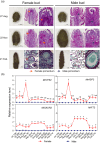The red bayberry genome and genetic basis of sex determination
- PMID: 29992702
- PMCID: PMC6335074
- DOI: 10.1111/pbi.12985
The red bayberry genome and genetic basis of sex determination
Abstract
Morella rubra, red bayberry, is an economically important fruit tree in south China. Here, we assembled the first high-quality genome for both a female and a male individual of red bayberry. The genome size was 313-Mb, and 90% sequences were assembled into eight pseudo chromosome molecules, with 32 493 predicted genes. By whole-genome comparison between the female and male and association analysis with sequences of bulked and individual DNA samples from female and male, a 59-Kb region determining female was identified and located on distal end of pseudochromosome 8, which contains abundant transposable element and seven putative genes, four of them are related to sex floral development. This 59-Kb female-specific region was likely to be derived from duplication and rearrangement of paralogous genes and retained non-recombinant in the female-specific region. Sex-specific molecular markers developed from candidate genes co-segregated with sex in a genetically diverse female and male germplasm. We propose sex determination follow the ZW model of female heterogamety. The genome sequence of red bayberry provides a valuable resource for plant sex chromosome evolution and also provides important insights for molecular biology, genetics and modern breeding in Myricaceae family.
Keywords: Morella rubra; genome; sex-determining region; sex-linked marker.
© 2018 The Authors. Plant Biotechnology Journal published by Society for Experimental Biology and The Association of Applied Biologists and John Wiley & Sons Ltd.
Conflict of interest statement
Z.S.G., Y.W., H.M.J., H.B.Z., Y.J., C.Y.C. and G.Y.W. have two pending patents for the sex‐linked marker technique in China (201710221539.3 and 201710221205.6). The other authors declare they have no competing interests.
Figures





References
-
- Akagi, T. , Henry, I.M. , Tao, R. and Comai, L. (2014) A Y‐chromosome‐encoded small RNA acts as a sex determinant in persimmons. Science, 346, 646–650. - PubMed
-
- Allantospermum, A. , Apodanthaceae, A. , Boraginales, B. , Buxaceae, C. , Centrolepidaceae, C. , Cynomoriaceae, D. , Dilleniales, D. et al. (2016) An update of the Angiosperm Phylogeny Group classification for the orders and families of flowering plants: APG IV. Bot. J. Linn. Soc. 181, 1–20.
Publication types
MeSH terms
Substances
Grants and funding
LinkOut - more resources
Full Text Sources
Other Literature Sources
Miscellaneous

